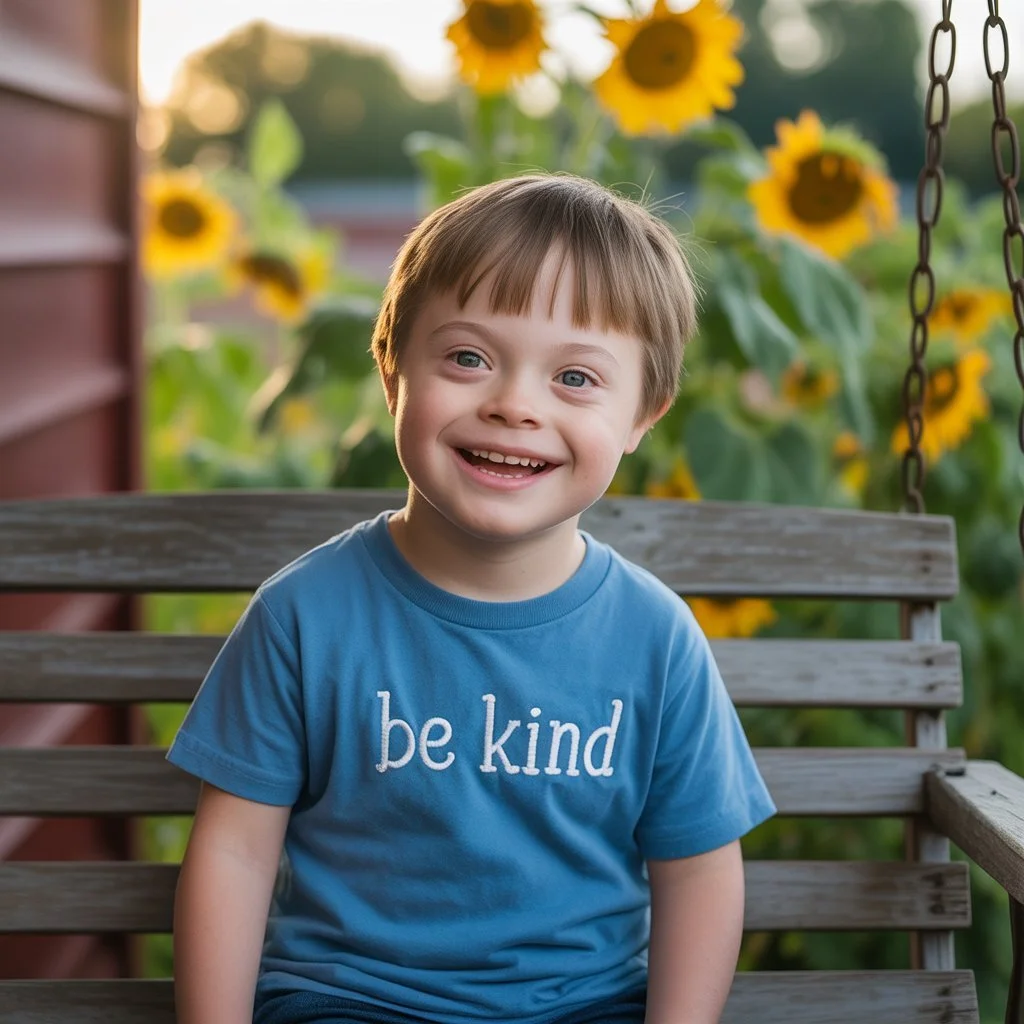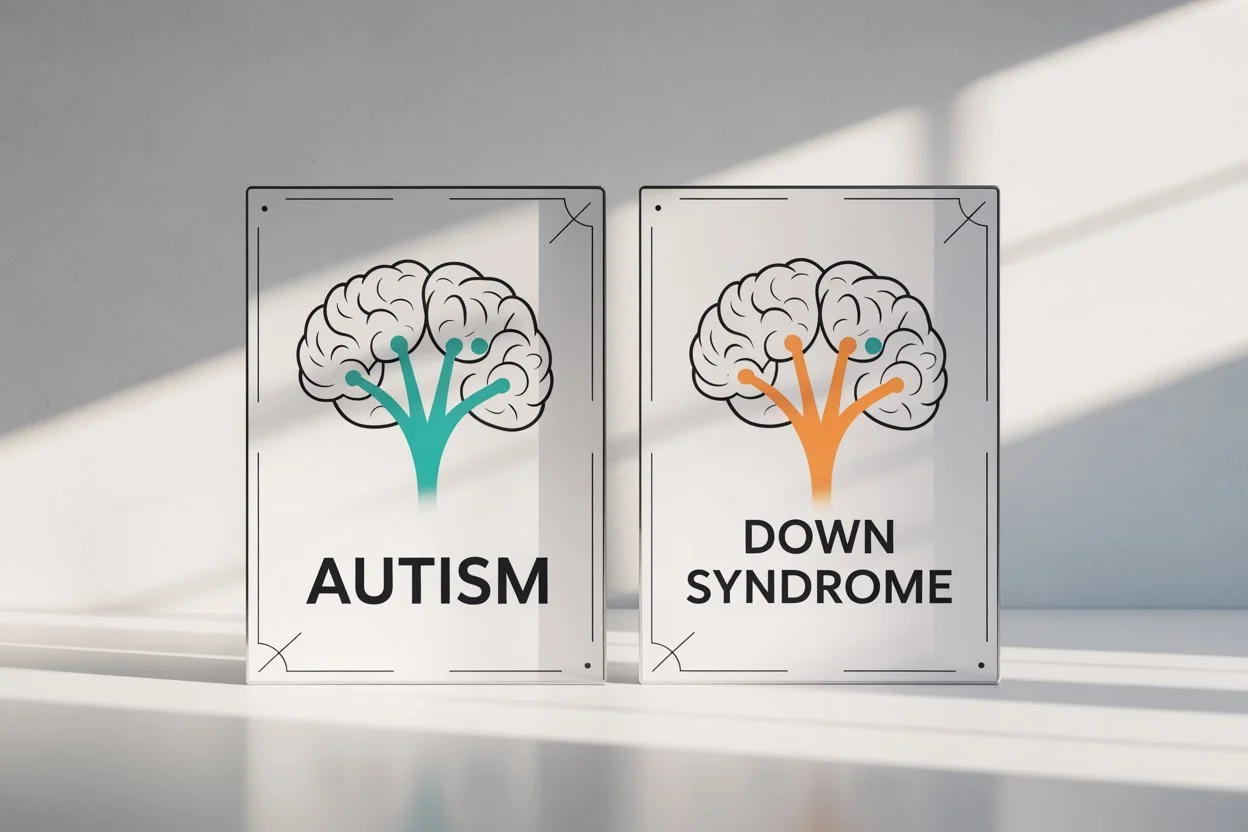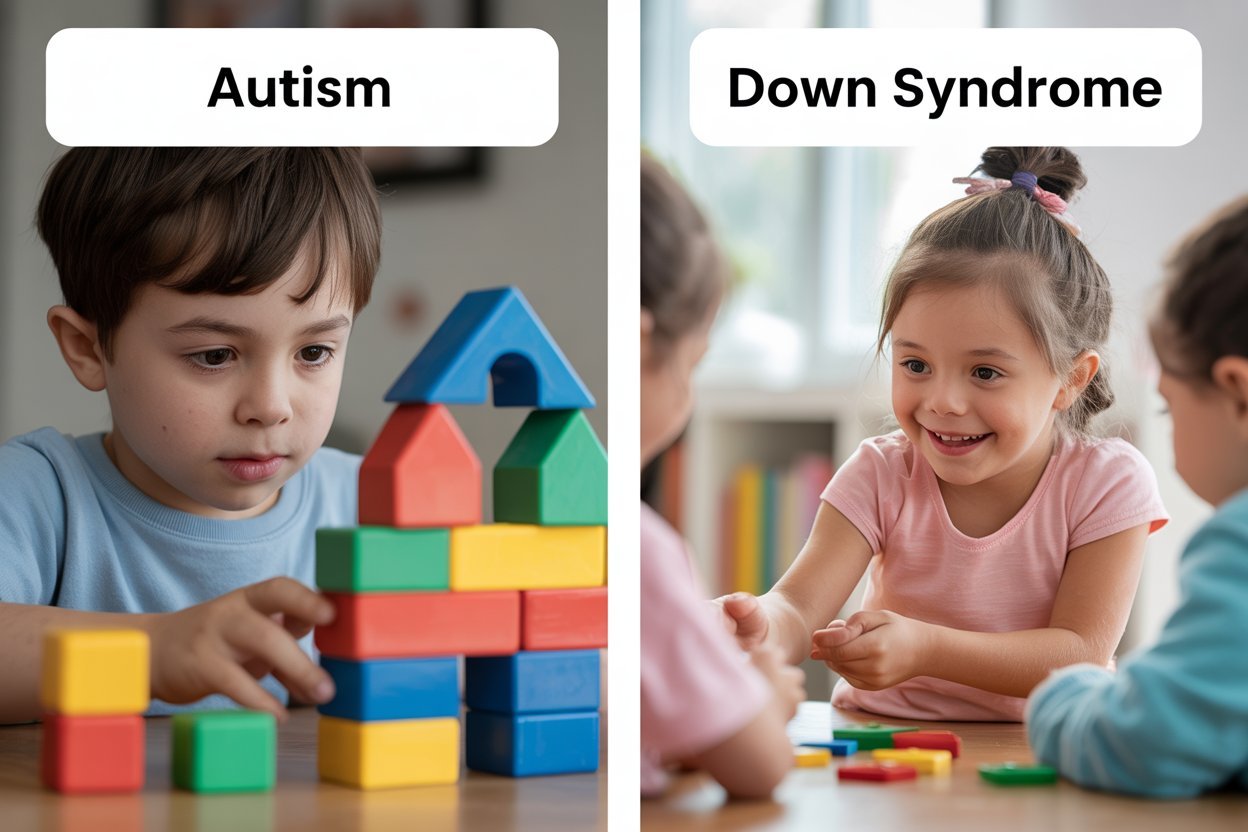Are Autism and Down Syndrome Related?
Table of Contents
Intro
What is Autism?
What is Down Syndrome?
How Are They Different?
Can Someone Have Both?
How to Better Understand and Support
If You Love or Work With Someone With Autism, Read This
Conclusion
Autism Spectrum Disorder and Down Syndrome
Many people wonder whether autism and Down syndrome are connected or similar conditions. This question comes up frequently among parents, caregivers, educators, and healthcare providers who notice some overlapping characteristics between the two conditions. While it's natural to look for connections when trying to understand developmental differences, the relationship between autism and Down syndrome is more complex than it might initially appear.
As such, the short answer is that autism and Down syndrome are distinct conditions with different causes, but they can occur together in the same person. They also share some similar challenges, which is why people sometimes confuse them or wonder about their relationship. However, understanding their differences is just as important as recognizing their similarities.
This article will explore what autism and Down syndrome actually are, how they differ, why they're sometimes confused, and how understanding both conditions can lead to better support for the individuals and families affected by them.
What is Autism?
Autism, officially called Autism Spectrum Disorder (ASD), is a neurodevelopmental condition that affects how people communicate, interact socially, and process sensory information. The word "spectrum" is used because autism affects people in many different ways and to different degrees.
Core Characteristics of Autism
Autism typically involves differences in several key areas:
Social communication and interaction: This might include difficulty with back-and-forth conversation, challenges understanding nonverbal communication like facial expressions, or differences in developing and maintaining relationships.
Restricted and repetitive patterns of behavior: This could involve repetitive movements like hand-flapping, intense focus on specific interests, strict adherence to routines, or unusual reactions to sensory input like sounds, textures, or lights.
Sensory processing differences: Many autistic people are either oversensitive or undersensitive to certain sensory experiences, such as loud noises, bright lights, or specific textures.
Key Signs of Autism
Common signs of autism include:
Difficulty with social interactions and reading social cues
Challenges with verbal and nonverbal communication
Repetitive behaviors or intense interests in specific topics
Need for routine and predictability
Sensory sensitivities or seeking certain sensory experiences
Difficulty with transitions or changes in plans
Autism Looks Different in Each Person
It's crucial to understand that autism presents very differently from person to person. Some autistic people are nonspeaking and need significant daily support, while others are highly verbal and live independently. Some have exceptional abilities in certain areas, while others may have intellectual disabilities. Some are diagnosed in early childhood, while others aren't identified until adulthood.
This diversity means that you can't always tell if someone is autistic just by looking at them or having a brief interaction. Autism is often called an "invisible disability" because many autistic people learn to mask their traits in social situations.
What Causes Autism
Autism is believed to result from a combination of genetic and environmental factors that affect brain development. Research shows that autism tends to run in families, suggesting a strong genetic component, but no single cause has been identified. Important to note: vaccines do not cause autism, despite persistent myths.
What is Down Syndrome?
Down syndrome is a genetic condition caused by having an extra copy of chromosome 21. This additional genetic material affects physical and intellectual development in characteristic ways.
The Genetic Basis
Unlike autism, Down syndrome has a clear, identifiable genetic cause. Typically, people have 46 chromosomes arranged in 23 pairs. People with Down syndrome have 47 chromosomes because they have three copies of chromosome 21 instead of the usual two. This is why Down syndrome is also called "Trisomy 21."
Key Traits of Down Syndrome
People with Down syndrome typically share certain physical characteristics:
Distinctive facial features, including almond-shaped eyes and a flatter facial profile
Lower muscle tone (hypotonia)
Shorter stature
A single deep crease across the palm of the hand
Intellectual and Developmental Effects
Down syndrome affects cognitive development, typically resulting in:
Mild to moderate intellectual disabilities
Delays in speech and language development
Challenges with memory and learning
Slower processing of information
However, the degree of intellectual disability varies significantly among individuals with Down syndrome. Many people with Down syndrome learn to read, write, work, and live semi-independently or independently.
Health Considerations
People with Down syndrome are at higher risk for certain health conditions:
Heart defects (present in about half of babies with Down syndrome)
Hearing and vision problems
Sleep apnea
Thyroid problems
Increased risk of certain infections
Strengths and Abilities
People with Down syndrome often have particular strengths:
Strong social skills and empathy
Good visual learning abilities
Determination and perseverance
Ability to learn and work when given appropriate support
How Are They Different?
While autism and Down syndrome can sometimes appear similar on the surface, they have fundamental differences in their causes, characteristics, and impacts.
Different Origins
Autism is a neurodevelopmental condition with complex causes involving multiple genes and possibly environmental factors. The exact mechanisms aren't fully understood, but autism involves differences in brain structure and function.
Down syndrome is a genetic condition with a clear, identifiable cause: an extra chromosome 21. This genetic difference affects development throughout the body, not just the brain.
Physical Differences
Down syndrome involves characteristic physical features that are usually recognizable. People with Down syndrome typically have distinctive facial features, shorter stature, and lower muscle tone.
Autism generally doesn't involve distinctive physical features. Most autistic people look no different from their non-autistic peers, which is why autism is often considered an invisible disability.
Communication and Social Differences
In autism: Communication challenges often involve difficulty with social communication rules, understanding nonverbal cues, and processing language. Many autistic people prefer direct, literal communication.
In Down syndrome: Communication challenges typically involve speech clarity, language development delays, and articulation difficulties. However, people with Down syndrome often have good social instincts and enjoy interacting with others.
Learning Style Differences
Autistic people often have uneven skill profiles. They might excel in certain areas while struggling significantly in others. Many have intense interests and can develop deep expertise in specific topics.
People with Down syndrome typically have more evenly distributed learning challenges. They often learn well through visual methods and repetition, and many benefit from hands-on learning approaches.
Sensory Processing
Autism frequently involves significant sensory processing differences. Autistic people might be overwhelmed by certain sounds, lights, or textures, or they might seek out intense sensory experiences.
Down syndrome can involve some sensory challenges, but these are typically less prominent and usually related to hearing or vision problems rather than sensory processing differences.
Behavioral Patterns
Autism often involves repetitive behaviors, intense interests, and strong needs for routine and predictability. Changes in routine can be very distressing.
Down syndrome doesn't typically involve the same types of repetitive behaviors or intense needs for routine, though individuals may certainly have preferences and habits.
Can Someone Have Both?
Yes, it's definitely possible for someone to have both autism and Down syndrome. Research suggests that autism occurs in people with Down syndrome at rates significantly higher than in the general population.
Co-occurrence Statistics
Studies indicate that autism occurs in approximately 16-18% of people with Down syndrome, compared to about 1-2% of the general population. This means that people with Down syndrome are much more likely to also be autistic than people without Down syndrome.
What Dual Diagnosis Looks Like
When someone has both conditions, they might show:
The characteristic physical features of Down syndrome
Communication challenges that are more severe than typical for Down syndrome alone
Social interaction difficulties that go beyond what's expected with Down syndrome
Repetitive behaviors and intense interests characteristic of autism
Sensory sensitivities not typically associated with Down syndrome alone
Stronger needs for routine and predictability
Challenges with Dual Diagnosis
Having both conditions can create unique challenges:
Diagnostic complexity: It can be difficult to determine which behaviors are related to Down syndrome versus autism, potentially leading to delayed or missed autism diagnosis.
Support needs: The person might need support strategies that address both conditions, which can be more complex to develop and implement.
Communication: Speech and language challenges might be more significant when both conditions are present.
Social interaction: While people with Down syndrome typically have good social instincts, adding autism can create more complex social challenges.
Strengths with Dual Diagnosis
People with both conditions also bring unique strengths:
The social warmth often associated with Down syndrome combined with the focused interests of autism
Determination and perseverance common in Down syndrome along with the deep thinking abilities often found in autism
Visual learning strengths that can be enhanced by autism's attention to detail
Why the Confusion?
Several factors contribute to confusion between autism and Down syndrome:
Overlapping Challenges
Both conditions can involve:
Delays in speech and language development
Challenges with social interaction
Learning differences and intellectual disabilities (in some cases)
Need for additional support in educational and social settings
Communication Similarities
Both autistic people and people with Down syndrome might:
Have difficulty with certain aspects of communication
Need extra time to process information
Benefit from visual supports and clear, concrete language
Experience frustration when they can't communicate effectively
Media Representation and Stereotypes
Unfortunately, media representations often oversimplify both conditions, leading to stereotypes that can blur the distinctions between them. Movies and TV shows might portray people with developmental disabilities in similar ways, regardless of their specific condition.
Limited Public Understanding
Many people have limited knowledge about developmental disabilities in general, leading them to group different conditions together or assume they're all similar.
Educational and Support Settings
In some educational or support settings, people with different developmental disabilities might receive similar services or be grouped together, which can contribute to confusion about the distinctions between conditions.
Why Accurate Understanding Matters
Confusion between autism and Down syndrome can have real consequences:
Missed diagnoses: If someone with Down syndrome also has autism, their autism might be overlooked, leading to inadequate support.
Inappropriate expectations: Misunderstanding someone's condition can lead to expectations that are either too low or inappropriate for their actual abilities and challenges.
Ineffective support: Support strategies that work for one condition might not be effective for the other, leading to frustration and limited progress.
Reduced opportunities: Stereotypes and misconceptions can limit opportunities for education, employment, and social participation.
How to Better Understand and Support
Understanding both autism and Down syndrome leads to better support for individuals and families affected by these conditions.
Be Patient and Keep Learning
Supporting someone with autism, Down syndrome, or both requires ongoing learning and patience:
Recognize that every person is unique, regardless of their diagnosis
Stay curious about the individual's specific needs, preferences, and abilities
Be willing to adjust your approaches based on what works for that particular person
Understand that development and abilities can change over time
Ask Questions and Listen
Rather than making assumptions based on a diagnosis:
Ask the person (when possible) or their family about their specific needs and preferences
Listen to their experiences and perspectives
Respect their communication style and give them time to respond
Focus on the individual rather than the label
Educate Yourself
Take time to learn about both conditions from reliable sources:
Read current research and information from reputable organizations
Learn from autistic people and people with Down syndrome themselves
Understand that old stereotypes and outdated information can be harmful
Recognize that both conditions exist on spectrums of ability and need
Focus on Strengths
Both autistic people and people with Down syndrome have valuable strengths and abilities:
Look for and build on individual strengths rather than focusing only on challenges
Create opportunities for people to use their abilities and interests
Celebrate achievements and progress, no matter how small they might seem
Recognize that everyone has something valuable to contribute
Create Inclusive Environments
Whether in schools, workplaces, or communities:
Design environments that work for people with different abilities and needs
Provide multiple ways for people to communicate and participate
Offer appropriate supports without being condescending
Foster acceptance and understanding among all community members
If You Love or Work With Someone With Autism, Read This
If there's someone in your life who's autistic, whether it's a family member, student, friend, or colleague, understanding their experience from the inside is crucial for providing meaningful support. While clinical information about autism is important, nothing replaces hearing directly from autistic people about what their lives are really like.
Sonia Krishna Chand's book "Dropped in a Maze" is a powerful and essential read for anyone who wants to truly understand the autistic experience. This isn't just another clinical book about autism written from an outside perspective. It's an honest, raw, and deeply personal account of living with autism, particularly as someone who wasn't diagnosed until adulthood.
Why This Book Matters
Sonia's story provides insights that no medical textbook can offer. She writes about the confusion of living for years without understanding why certain things felt so difficult, the exhaustion of constantly trying to fit into a neurotypical world, and the relief and clarity that came with finally receiving an autism diagnosis.
Her book covers the daily realities of autism that often go unrecognized: the overwhelming nature of social situations, the intense effort required for activities that seem simple to others, and the constant work of translating between autistic and neurotypical ways of experiencing the world.
For Different Readers
This book offers value for various audiences:
Parents and family members can gain insight into what their autistic loved ones might be experiencing internally, even when they appear to be managing well on the surface.
Teachers and educators can better understand why certain teaching strategies work while others don't, and how to create more autism-friendly learning environments.
Friends and colleagues can develop empathy for the unique challenges their autistic peers face and learn how to provide better support.
Healthcare and support professionals can develop more effective, compassionate approaches to their work with autistic individuals.
Autistic people themselves can find validation, community, and strategies for their own journeys.
A Story of Identity and Understanding
What makes Sonia's book particularly powerful is her journey of self-discovery. As someone diagnosed later in life, she experienced years of feeling different without understanding why. Her story demonstrates that autism diagnosis, even in adulthood, can be liberating rather than limiting.
She writes with both personal insight and professional understanding, as she's both an autistic person and a licensed therapist. This dual perspective provides a unique depth to her observations about autism, mental health, and the importance of accurate diagnosis and appropriate support.
Moving Beyond Stereotypes
"Dropped in a Maze" challenges many common stereotypes about autism. Sonia's experience shows that:
Autism doesn't always look like the portrayals in movies or media
Intelligent, successful people can be autistic and still struggle significantly in daily life
Women's autism is often missed or misdiagnosed, leading to years of confusion
Late diagnosis is more common than many people realize
Understanding autism can transform someone's relationship with themselves
If You Want to Truly Understand
If you want to truly understand what it feels like to live inside the maze of autism, this book will open your eyes. Sonia's writing is accessible and engaging, making complex topics understandable without being condescending. She shares both struggles and triumphs, providing a balanced view of autism that respects both its challenges and its strengths.
This is essential reading for anyone who wants to move beyond surface-level understanding of autism to genuine empathy and effective support. Whether you're a parent trying to understand your child, a teacher working with autistic students, or simply someone who wants to be a better ally to autistic people in your community, this book provides the insight and understanding you need.
Get a copy of "Dropped in a Maze" on Amazon today.
Conclusion
Autism and Down syndrome are distinct conditions with different causes, characteristics, and support needs. While they can occur together and share some surface similarities, understanding their differences is crucial for providing appropriate support and avoiding harmful stereotypes.
The key to providing good support is recognizing that every person is unique, regardless of their diagnosis. Labels like "autism" or "Down syndrome" provide important information about potential support needs, but they don't define everything about a person's abilities, interests, or potential.
Whether someone has autism, Down syndrome, both, or neither, they deserve to be seen as a whole person with their own strengths, challenges, interests, and dreams. Our job as family members, friends, educators, and community members is to provide the support and understanding that helps everyone reach their potential and live fulfilling lives.





